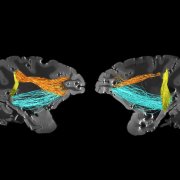As you read this line, you’re bringing each word into clear view for a brief moment while blurring out the rest, perhaps even ignoring the roar of a leaf blower outside. It may seem like a trivial skill, but it’s actually fundamental to almost everything we do. If the brain weren’t able to pick and choose what portion of the incoming flood of sensory information should get premium processing, the world would look like utter chaos—an incomprehensible soup of attention-hijacking sounds and sights.
Meticulous research over decades has found that the control of this vital ability, called selective attention, belongs to a handful of areas in the brain’s parietal and frontal lobes. Now a new study suggests that another area in an unlikely location—the temporal lobe—also steers the spotlight of attention.
The unexpected addition raises new questions in what has long been considered a settled scientific field. “The last time an attention controlling area was discovered was 30 years ago,” says Winrich Freiwald, head of Rockefeller’s Laboratory of Neural Systems, who published the findings in the Proceedings of the National Academy of Sciences. “This is a fundamental discovery that might require a rethinking of old concepts about attentional control.”
A serendipitous discovery
Freiwald and his colleague Heiko Stemmann at the University of Bremen in Germany first encountered this brain area during an experiment a few years ago. They were studying brain activation in monkeys engaged in a task that requires maintaining focus on a subset of rapidly moving dots on a screen. As expected, visual areas specializing in motion detection, as well as areas known for selective attention, lit up on brain scans.
But there was also area PITd, named for its location in the dorsal part of the posterior inferotemporal cortex, whose activation the scientists couldn’t quite explain. “All of the areas we found made sense, except for this one,” Freiwald says.
Not only was it not known to contain any motion sensitive neurons, PITd also didn’t appear particularly sensitive to other types of visual information, suggesting it wasn’t a sensory processing area. So in the new study, the scientists asked if this mysterious brain area might be controlling attention. It seemed like a long shot, as PITd was far away from classic attention areas. “But we took the bet,” Freiwald says...
Read the full article on The Rockefeller University's website using the link below.

